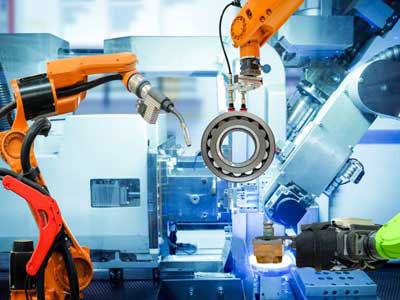Key Takeaway
The basis of industrial robots lies in automation, precision, and versatility. These robots are designed to handle repetitive and dangerous tasks with high accuracy. They consist of sensors to detect the environment, controllers to process information, and actuators to perform movements. The articulated frame allows these robots to move freely and efficiently. Industrial robots are programmable, which means they can be adapted for various tasks in manufacturing applications. Their ability to work continuously without fatigue makes them essential in modern industries, improving both productivity and safety.
Technological Foundations
At the core of industrial robots lie sophisticated technological advancements that have evolved over decades. These machines are not just mechanical arms but intricate systems integrated with sensors, actuators, and advanced control algorithms. Their ability to perform repetitive tasks with high accuracy stems from these technological foundations. From temperature monitoring to 3D mapping, these robots ensure efficiency, safety, and reliability, making them indispensable in modern industrial applications.

Key Innovations in Robotics
Articulated robotic arms represent a pivotal advancement in industrial automation, revolutionizing manufacturing processes across various sectors. These mechanical marvels are designed with multiple joints resembling a human arm, providing unparalleled flexibility and precision in executing complex tasks.
Initially introduced decades ago, articulated arms have undergone continuous refinement, integrating sophisticated sensors and actuators that enable them to mimic human movements with remarkable accuracy. This capability is crucial in industries requiring intricate assembly, such as automotive manufacturing and electronics production.
One of the key advantages of articulated arms lies in their versatility. They can perform a wide range of tasks, from welding and painting to intricate assembly operations, with consistent repeatability. This versatility reduces the need for human intervention in hazardous or repetitive tasks, thereby enhancing workplace safety and efficiency.
Moreover, advancements in software programming have empowered these robots to handle dynamic environments and adapt to varying production demands swiftly. Integrated vision systems enable them to perceive their surroundings, identify objects, and adjust their actions accordingly, making them indispensable in modern smart factories.
Role of Artificial Intelligence
Collaborative robots, or cobots, exemplify a paradigm shift in industrial robotics by fostering a symbiotic relationship between humans and machines within the manufacturing environment. Unlike traditional robots confined to safety cages, cobots are designed to operate alongside human workers, facilitating close collaboration and enhancing overall productivity.
The introduction of cobots addresses longstanding challenges in manufacturing, particularly in tasks requiring human dexterity and decision-making alongside the precision and strength of robots. This collaboration optimizes workflow efficiency, accelerates production cycles, and reduces operational costs significantly.
Key to the success of cobots is their inherent safety features and adaptive capabilities. Equipped with advanced sensors and AI algorithms, these robots can detect the presence of humans nearby and adjust their speed and force accordingly to prevent accidents. This capability not only enhances workplace safety but also encourages acceptance and integration among human workers.
Moreover, cobots are relatively easy to program and reconfigure, making them suitable for small-batch production and agile manufacturing environments. Their flexibility extends to diverse applications, from assembly and packaging to quality inspection and logistics, fostering innovation and responsiveness in modern manufacturing.
Manufacturing and Assembly Processes
In the realm of manufacturing and assembly processes, industrial robots play a pivotal role in transforming production efficiency and precision. These robots are adept at handling repetitive tasks that require consistent quality, such as welding, painting, and assembling components. Their precision ensures that every weld joint is perfectly executed, every painted surface is flawlessly coated, and every component is assembled with meticulous accuracy.
Industrial robots are particularly valued in modern factories where they streamline operations, significantly reducing production cycle times. By automating tasks that are hazardous or physically demanding for humans, robots not only enhance workplace safety but also enable human workers to focus on more complex and strategic aspects of production.
The integration of robots into manufacturing workflows involves sophisticated programming and the use of advanced technologies like artificial intelligence and machine learning. These technologies empower robots to adapt to varying production demands dynamically, ensuring continuous operation and optimal performance. From automotive assembly lines to electronics manufacturing, robots contribute indispensably to achieving consistent output quality while meeting stringent production deadlines.
Key Components and Materials
Industrial robots are meticulously engineered using robust materials such as aluminum alloys and steel, ensuring durability and structural integrity in demanding industrial environments. These materials are chosen for their ability to withstand rigorous use and maintain operational reliability over extended periods.
Key components of industrial robots include servo motors, reducers, and end-effectors, each playing a crucial role in enabling precise and efficient robotic movements. Servo motors provide the necessary torque and speed control, allowing robots to execute movements with pinpoint accuracy. Reducers help in translating the high-speed output of servo motors into precise, low-speed motion required for tasks like picking and placing components.
End-effectors, also known as robot grippers or tools, are designed to interact with the workpiece or tooling in specific ways. They are tailored to the application requirements, whether it involves gripping delicate electronic components or handling heavy automotive parts. The design and selection of end-effectors are critical in optimizing the robot’s performance and ensuring compatibility with the tasks it performs.
Conclusion
In conclusion, industrial robots stand on a solid foundation of technological prowess, continuous innovation, and the integration of artificial intelligence. They have transformed manufacturing landscapes worldwide, offering efficiency, safety, and scalability. As you embark on your journey in the industry, understanding these basics will provide a clear roadmap to grasp the intricacies and potentials of industrial robotics.
